I have some really good news for you: There’s no magic involved in choosing and qualifying leads when you are selling to large and enterprise companies.
There is a proven system, of course, and I’ll teach it to you right here in this article. But it’s not magic. And it’s certainly not a secret.
When Showcase first started working with larger companies, I felt like this subject was wrapped up in way too much mystery. Articles online used fancy terms like lead scoring, qualifying, and sales pipeline like they were magic words. And if you just speak those magic words with enough conviction, perfect leads appear!
That’s not how things work.
In fact, finding and qualifying leads is as straightforward with large and enterprise companies as it is with small and medium businesses. You just have to tweak your focus a bit.
The advice that follows in this article is not a fancy “growth hack.” It’s not a tool that’s going to magically deliver a bunch of leads for little effort. It does require a bit of time and patience — but the result will be a well-qualified database of leads to get started with.
Preparation Misconceptions
Before we get to Step 1, I want to clear up some incorrect notions I see floating around in entrepreneurial and SMB circles.
-
The only way to break into this market is by doing a bunch of advertising and generating a big list of interested leads.
-
You have to be a slick salesperson, with a fancy presentation all ready to go and have the sales process all mapped out before you make a start.
While these things might be helpful, they are far from essential to begin with.
These misconceptions seem to reflect a false belief that way too many of us hold when we first set out to sell to larger companies — that we need to be way more prepared than we currently are before we are ready to start on sales outreach.
In The Big Leap, a fantastic book from Gay Hendricks that talks about overcoming fear, this kind of false belief is called a “limiting belief” or an “upper limit problem.” It’s a self-imposed, manufactured excuse for not taking the next step — and it stems from fear.
But it is false!
The truth is you can start right where you are.
Let’s look at the two misconceptions from a practical standpoint:
Even if you do have a budget set aside for a marketing and advertising campaign, now is probably not the time to spend it willy-nilly. If you haven’t sold to big companies before, you likely don’t have a narrow enough understanding of this audience…or who exactly to target in a marketing campaign. Chances are you’d throw that budget into Google, Facebook or LinkedIn on a hope and a prayer…and hopes and prayers are rarely good approaches to running marketing campaigns.
Maybe you think you need to run a big marketing campaign because you’d prefer the leads come directly to you. The idea of doing cold outreach or having to (ugh) sell sounds skeezy and desperate. I’m sorry to break it to you, but to grow a business, you have to sell. And even if your marketing campaign is a smash hit and lands you a long list of highly qualified leads — you still have to sell to those leads.
Finally, being super prepared with a kick-arse presentation will absolutely increase your chances of success…but you don’t need this before you start prospecting. Don’t let this hold you back from starting! Use the three-step process I outline next, and I’ll tell you exactly what you need to make your presentation out-of-this-world in a later post.
Step 1: Zero in on the Right Job Titles
Grab a pen and paper, open up a blank Excel worksheet, or make a copy of this Google Sheets template I created for you.
Set up four columns with these titles:
- Client name
- Industry
- Current title
- Possible title at a large or enterprise company
Fill in the first column with a list of the names of your current clients.
Add those clients’ industries to column two, and their current titles in column three.
Now comes the part that requires a bit more thought…
Think about what that client’s title might be if they were at a larger company and they remained your main point of contact. For example, maybe your current client is the owner of their small business — but at a larger company, the role that would likely buy your services might be something like “Marketing Manager” or “Head of Operations.”
If you feel lost already, don't give up! Just skip this part and keep going.
Step 2: Narrow the List — and Let Love Guide the Way
Now go back through your list and cross out or delete the clients you don’t love to work with.
This is not a personal exercise. Don’t cross off clients that you dislike because of personality clashes. Cross them off if you just don’t enjoy the work you do for them — because life is too short to do work you don’t love.

Don’t worry if your remaining list is kind of a short one. In fact, a smaller list might serve you better as you move into Step 3. You’re about to discover a world of possibility with just these few customer details…
Step 3: Use LinkedIn Like a Pro
List in hand, head over to LinkedIn.
If you’ve already established a big network of high-quality contacts as part of your own LinkedIn profile, you’re ahead of the game. You can try this step for free.
If your network is small, however, you’re probably going to have to sign up for LinkedIn Sales Navigator to get access to a larger number of users on the platform.
Sales Navigator is not cheap, but you can get the first month for free to try it out before you pay for it. In fact, I recommend you explore the free trial even if you do have a large network. It may be a worthwhile investment.
Now follow these steps to build your new list of large-and-enterprise leads:
1.Use the search box at the top of LinkedIn to search for the first “possible” job title on your list. E.g. “marketing manager.”

2.You’ll see a list of filters come up once you hit the search button. If you’re using your free account, it’ll appear to the right. If you’re using Sales Navigator, it’ll appear to the left with the filters below. (Of course, the LinkedIn interface changes all the time, so that might have changed by the time you read this!)
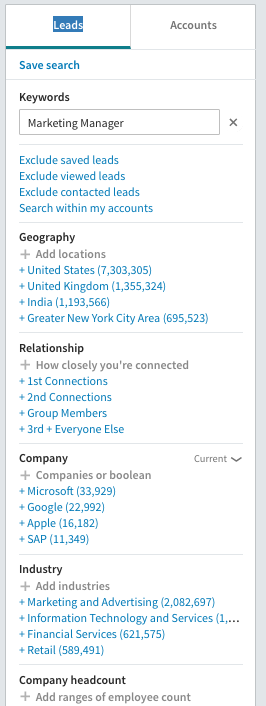
3.Start filtering out for your particular criteria. For example, if you need or want to get face-to-face to sell your product or service, you might filter for locations that you're willing to drive or travel to.
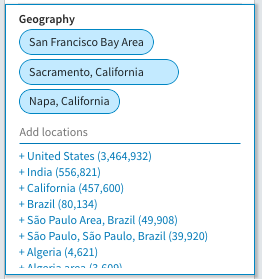
4.Next, filter for company size to eliminate the small and medium businesses from your new lead list.
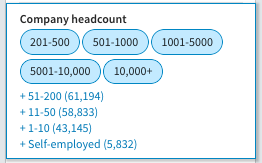
5.Continue filtering for your unique criteria.
For example, you'll want to filter for level of seniority if you’ve chosen a more generic search term such as “sales” or even "Marketing Manager" like my example and you know that an entry-level staff member is not going to be your buyer.
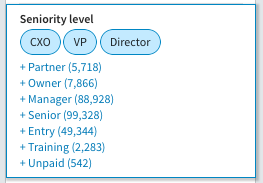
You'll also find the Industry filter handy to narrow the list. Start by entering the industries of your current customers. If that makes the list too small, add in a few other industries that you’d really like to work with.
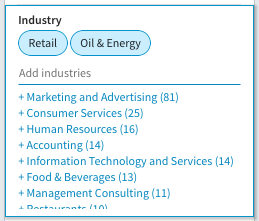
6.Now you might have a manageable list there on LinkedIn. If, however, that list is still showing tens of thousands of leads, I suggest you refine further by job function and by relationship to you (closest in your network). Ideally, you will get your list of leads down to around 200.
Now you’ve got your initial list. It’s time to put some thought into who you want to keep for your final list.
Look at the profiles of the people on your initial list. Who appears to be a lot like your existing customers? Those are the leads you should focus on first.
If you’re using Sales Navigator, you can tag those people as leads and come back to them in the future. If you’re using your free LinkedIn account, start a new spreadsheet and pop in the links to those lead profiles so you don’t lose track of them.
By the end of this, you should have 5-20 really solid large-and-enterprise leads to start with.
Scalability May Be Sexy, but Focus First on Practicality
The process I described above might not be fancy, but it is exactly how I got many of my leads at big companies. In fact, I still use it occasionally to get new leads.
Is this method super scalable? Probably not. But when you are trying to grow a small company, it’s wise to ignore the siren song of “scalability” and instead focus on practical steps that work now.
This process of getting leads does require some slow and methodical work, but you’ll be rewarded for it.
Now you just have to introduce yourself. And that’s exactly what I’m covering in my next post!
Read the next article in the Small Fish, Big Fish series: How to Land the First Meeting With Your Enterprise Lead
Read past articles in the Small Fish, Big Fish series:
Or grab the whole series as a free ebook: Small Fish, Big Fish: A small-business guide to selling to large and enterprise companies.